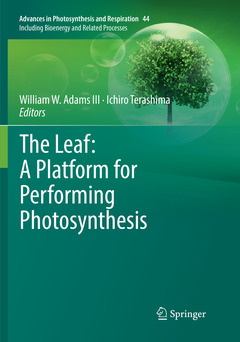The Leaf: A Platform for Performing Photosynthesis, Softcover reprint of the original 1st ed. 2018 Advances in Photosynthesis and Respiration Series, Vol. 44
Coordonnateurs : Adams III William W., Terashima Ichiro

The leaf is an organ optimized for capturing sunlight and safely using that energy through the process of photosynthesis to drive the productivity of the plant and, through the position of plants as primary producers, that of Earth?s biosphere. It is an exquisite organ composed of multiple tissues, each with unique functions, working synergistically to: (1) deliver water, nutrients, signals, and sometimes energy-rich carbon compounds throughout the leaf (xylem); (2) deliver energy-rich carbon molecules and signals within the leaf during its development and then from the leaf to the plant once the leaf has matured (phloem); (3) regulate exchange of gasses between the leaf and the atmosphere (epidermis and stomata); (4) modulate the radiation that penetrates into the leaf tissues (trichomes, the cuticle, and its underlying epidermis); (5) harvest the energy of visible sunlight to transform water and carbon dioxide into energy-rich sugars or sugar alcohols for export to the restof the plant (palisade and spongy mesophyll); and (6) store sugars and/or starch during the day to feed the plant during the night and/or acids during the night to support light-driven photosynthesis during the day (palisade and spongy mesophyll). Various regulatory controls that have been shaped through the evolutionary history of each plant species result in an incredible diversity of leaf form across the plant kingdom. Genetic programming is also flexible in allowing acclimatory phenotypic adjustments that optimize leaf functioning in response to a particular set of environmental conditions and biotic influences experienced by the plant. Moreover, leaves and the primary processes carried out by the leaf respond to changes in their environment, and the status of the plant, through multiple regulatory networks over time scales ranging from seconds to seasons. This book brings together the findings from laboratories at the forefront of research into various aspects of leaf function, with particular emphasis on the relationship to photosynthesis.
William W. Adams III, a Professor at the University of Colorado, has pursued a lifelong passion for leaves. An investigation of the heterophyllous leaves (trichome-covered, atmospheric juvenile versus glabrous, tank-forming adult leaves) of an epiphytic bromeliad was followed by PhD research on photosynthesis and photoinhibition of plants with crassulacean acid metabolism. After postdoctoral work into leaf senescence, pollution impacts on leaves, and photosynthesis and photoprotection in leaves, cladodes, and lichens, he moved to Colorado in 1989. During the intervening years, he, his wife and colleague (Prof. Barbara Demmig-Adams), and their students explored the regulation and ecophysiology of photosynthesis, photoprotection, and photoinhibition of numerous species under controlled conditions and in many habitats including the understory of sunfleck-dappled forests, arid and desert landscapes, grasslands, and montane and subalpine forests. More recently, they discovered significant relationships between foliar phloem and xylem architecture (underlying capacities to load and export sugars and distribute water within the leaf), photosynthesis, and transpiration that vary among species and exhibit acclimatory adjustment to environmental growth conditions. The Leaf represents the renewal of ties between William and Ichiro that were initiated during their PhD and postdoctoral work, respectively, at the Australian National University in the mid-1980s.
Ichiro Terashima began his study on the light environment within individual leaves and its effect on leaf photosynthesis with Prof. Toshiro Saeki, miniaturizing his supervisor’s study at the leaf canopy scale to the individual leaf scale. He subsequently conducted an eco-devo study examining effects of light direction on differentiation of palisade and spongy tissues in bifacial leaves with Prof. Noboru Hara, a plant anatomist. He then moved to the Australian National Unive
Date de parution : 12-2018
Ouvrage de 575 p.
17.8x25.4 cm
Date de parution : 11-2018
Ouvrage de 575 p.
17.8x25.4 cm
Disponible chez l'éditeur (délai d'approvisionnement : 15 jours).
Prix indicatif 263,74 €
Ajouter au panierThèmes de The Leaf: A Platform for Performing Photosynthesis :
Mots-clés :
C3 photosynthesis; C4 photosynthesis; Leaf structure; abiotic stress; biotic influences



